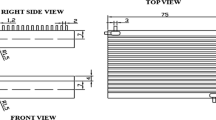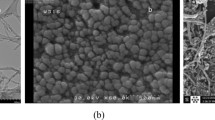Abstract
The result of experimental investigation of the influence of nanofluids on the enhancement of heat transfer in a microchannel heat sink is presented in the paper. The microchannel heat sink has 25 numbers of rectangular microchannels of 0.42 mm width, 4.2 mm depth and 100 mm length. Nanofluids of Al2O3/water and SiO2/water with volume concentration of 0.1% and 0.25% and deionized water were used as heat transfer fluids. The nanofluid and its volume concentration are found to affect the heat transfer. Significant heat transfer enhancement of the microchannel is observed with the nanofluids when compared to deionized water. Nanofluid Al2O3/water exhibits better heat transfer performance than SiO2/water due to the higher thermal conductivity of Al2O3/water. Nanofluids with higher volume concentration show better heat transfer enhancement. The additional pressure drop caused by the nanofluids is not so high.








Similar content being viewed by others
References
Hetsroni G, Mosyak A, Pogrebnyak E, Yarin LP (2005) Fluid flow in microchannels. Int J Heat Mass Transf 48:1982–1998
Kandlikar SG (2012) History, Advances and Challenges in liquid flow and flow boiling Heat transfer in microchannels. Critical Rev J Heat Transf 134:1–12
Kadam ST, Kumar R (2014) Twenty first century cooling solution: microchannel heat sinks. Int J Therm Sci 85:73–92
Tuckerman DB, Pease RFW (1981) High performance heat sinking for VLSI. IEEE Elect Device Lett EDL-2:126–129
Choi SUS (1995) Enhancing thermal conductivity of fluids with nanoparticles. ASME FED 231:99–103
Choi SUS, Zhang ZG, Yu W, Lockwood FE, Grulke EA (2001) Anomalously thermal conductivity enhancement in nanotube suspensions. Aplied Physics Lett 79:2252–2254
Das SK, Putra N, Thiesen P, Roetzel W (2003) Temperature dependence of thermal conductivity measurement of nanofluids. J Heat Transf 125:567–557
Hamilton RL, Crosser OK (1962) Thermal conductivity of heterogeneous two – component systems. I& EC Fundamentals 1:187–191
Singh PK, Harikrishna PV, Sundararajan T, Das SK (2012) Experimental and numerical investigation into the hydrodynamics of nanofluids in microchannels. Exp Thermal Fluid Sci 42:174–186
Wu JM, Zhao J (2013) A review of nanofluid heat transfer and critical heat flux enhancement- Research gap to engineering aplication. Prog Nucl Energy 66:13–24
Mohammed HA, Baskaran G, Shuaib NH, Abu-Mulaweh (2011) Influence of nanofluids on parallel flow square microchannel heat exchanger performance. Intern Comm Heat Mass Transf 38:1–9
Mirzaei M (2013) Maziar dehghan, Investigation of flow and heat transfer of nanofluid in microchannel with variable property aproach. Heat Mass Transf 49:1803–1811
Lelea D (2011) The performance evaluation of Al2O3 / water nanofluid flow and heat transfer in microchannel heat sink. Int J Heat Mass Transf 54:3891–3898
Hung T-C, Yan W-M, Wang X-D, Chang C-Y (2012) Heat transfer enhancement in microchannel heat sinks using nanofluids. Int J Heat Mass Transf 55:2559–2570
Fani B, Abbassi A, Kalteh M (2013) Effect of nanoparticle size on thermal performance of nanofluid in a trapezoidal microchannel – heat- sink. Int Comm Heat Mass Trans 45:155–161
Kalteh M (2013) Investigating the effect of various nanoparticle as base liquid types on the nanofluids heat and fluid flow in a microchannel. Appl Math Model 37:8600–8609
Mohammadian YY, Shahabeddin K, Zhang Y (2015) Analysis of performances of a manifold microchannel heat sink with nanofluids. Int J Thermal Sci 89:305–313
Lee J, Mudawar I (2007) Assessment of the effectiveness of nanofluids for single -phase and two – phase heat transfer in micro-channels. Int J Heat Mass Transf 50:452–463
Chein R, Chuang J (2007) Experimental microchannel heat sink performance studies using nanofluids. Int J Therm Sci 46:57–66
Ho CJ, Wei LC, Li ZW (2010) An experimental investigation of forced convective cooling performance of a microchannel heat sink with Al203/ water nanofluid. Aplied Thermal Eng 3:96–103
Karami N, Rahimi M (2014) Heat transfer enhancement in a hybrid microchannel-photovoltaic cell using Boehmite nanofluid. Intern Comm Heat Mass Transr 55:45–52
Pak BC, Cho Y (1988) Hydrodynamic and heat transfer study of dispersed fluids with submicron metallic oxide particle. Exp Heat Transf 11:151–170
Maxwell JC (1954) Treatise on electricity and magnetism. Dover, New York
Xuan Y, Roetzel W (2000) Conceptions for heat transfer correlation of nanofluids. Int J Heat Mass Transf 43:3701–3707
Einstein A (1956) Investigation on the theory of Brownian motion. Dover, Newyork
T.G. Beckwith, R.D. Marangoni, J.H. Lienhard, Mechanical measurements, fifth ed. Addison-Wesley Publishing Company, New York, 45–112(1990)
Yu CJ, Ritcher AG, Datta A, Durbin MK, Dutta P (2000) Molecular layering in a liquid on a solid substrate: an X-ray reflectivity study. Physica B 283:27–31
Keblinski P, Phillpot SR, Choi SUS, Eastman JA (2002) Mechanisms of heat flow in suspensions of nano-sized particles (nanofluids). Int J Heat Mass Transf 45:855–863
Haridas D, Rajut NS, Srivastava A (2015) Interferometric study of heat transfer characteristics of Al2O3 and SiO2 –based dilute nanofluids under simultaneously developing flow regime in compact channels. Int J Heat Mass Transf 88:713–727
Manay E, Sahin B (2016) The effect of microchannel height on performance of nanofluids. Int J Heat Mass Transf 95(307–320)
Yang Y-T, Tsai K-T, Wang Y-H, Lin S-H (2014) Numerical study of microchannel heat sink performance using nanofluids. Intern Comm Heat Mass Transf 57:27–35
Acknowledgements
The authors would like to thank the Management, Principal, and QC-ARD of K.L.N. College of Engineering, Madurai, India for the financial and administrative support to carry out the research work.
Author information
Authors and Affiliations
Corresponding author
Rights and permissions
About this article
Cite this article
Thansekhar, M.R., Anbumeenakshi, C. Experimental Investigation of Thermal Performance of Microchannel Heat Sink with Nanofluids Al2O3/Water and SiO2/Water. Exp Tech 41, 399–406 (2017). https://doi.org/10.1007/s40799-017-0189-y
Received:
Accepted:
Published:
Issue Date:
DOI: https://doi.org/10.1007/s40799-017-0189-y




